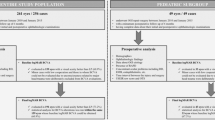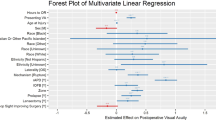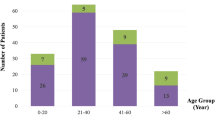Abstract
Objectives
To describe the epidemiologic and clinical characteristics of open globe injuries (OGIs) treated in a tertiary hospital and analyse predictors of visual outcome.
Methods
This retrospective observational study included all patients with OGIs admitted to Cruces University Hospital between 2010 and 2020. The descriptive analysis included demographic data, type of injury classified as “rupture”, “penetration”, “perforation”, or “intraocular foreign body”, trauma mechanism and setting, injury zone, Ocular Trauma Score, delay to surgery, length of hospital stay, antibiotic prophylaxis, initial and final best corrected visual acuity (BCVA), complications and further surgery. Univariate analysis and logistic regression were performed to identify prognostic factors, based on final BCVA.
Results
Overall, 207 OGI cases were reported. The most common type of injuries were ruptures caused by domestic falls. Notably, 44.4% of eyes developed phthisis bulbi. In the univariate analysis, the following variables were significantly linked to visual outcome: age > 60 years, “rupture”, “fall”, posterior and/or combined zones of injury, lens damage, retinal/choroidal detachment, initial BCVA of no light perception, and Ocular Trauma Score ≤ 2 (p < 0.001). Delay to surgery, length of stay and further surgery did not have prognostic value. In the logistic regression, initial BCVA of no light perception (p < 0.001) and injury zone III (p = 0.005) remained significant predictors of poor outcome.
Conclusions
In the population studied, most OGIs were caused by domestic falls usually affecting elderly patients with comorbidities. Visual outcome depended on patients´ specific characteristics and the nature of the trauma itself, whereas environmental factors failed to show any prognostic value.
This is a preview of subscription content, access via your institution
Access options
Subscribe to this journal
Receive 18 print issues and online access
$259.00 per year
only $14.39 per issue
Buy this article
- Purchase on Springer Link
- Instant access to full article PDF
Prices may be subject to local taxes which are calculated during checkout
Similar content being viewed by others
Data availability
The datasets generated and analysed during the current study are not publicly available due to confidentiality agreements, but are available from the corresponding author on reasonable request.
References
Negrel A, Thylefors B. The global impact of eye injuries. Ophthalmic Epidemiol. 1998;5:143–69.
Ng SMS, Low R, Hoskin AK, Rousselot A, Gunasekeran DV, Natarajan S, et al. The application of clinical registries in ophthalmic trauma. The International Globe and Adnexal Trauma Epidemiology Study (IGATES). Graefe’s Arch Clin Exp Ophthalmol. 2021. https://doi.org/10.1007/s00417-021-05493-6.
Agrawal R, Shah M, Mireskandari K, Yong GK. Controversies in ocular trauma classification and management: Review. Int Ophthalmol. 2013;33:435–45.
Mittra RA, Mieler WF. Controversies in the management of open-globe injuries involving the posterior segment. Surv Ophthalmol. 1999;44:215–25.
León F, Taboada J, Guimerá V. Traumatismos oculares graves en España. Factores epidemiológicos, estudio de las lesiones y medidas de prevención. León F, 1994:12–27.
Ferreiro J, Gálvez C, González A. Envejecimiento y Mercado de Trabajo En Euskadi. Publicaciones Universidad de Deusto (2011)
Kuhn F, Morris R, Witherspoon CD, Heimann K, Jeffers JB, Treister G, et al. A standardized classification of ocular trauma. Ophthalmology. 1996;103:240–3.
Kuhn F, Morris R, Witherspoon CD, Mester V. Birmingham Eye Trauma Terminology system (BETT). J Fr Ophtalmol. 2004;27:206–10.
Pieramici DJ, Sternberg P Jr, Aaberg TM, Bridges WZ Jr, Capone A Jr, Cardillo JA, et al. A system for classifying mechanical injuries of the eye (globe). Am J Ophthalmol. 1997;123:820–31.
Kuhn F, Maisiak R, Mann L. The ocular trauma score. Ophthalmol Clin N. Am. 2002;15:163–5.
Scott R. The ocular trauma score. Community Eye Health. 2015;28:44–45.
Basque Statistics Institute (EUSTAT). Demographic indicators. Municipal inhabitants statistics. Population projections. 2022. https://www.eustat.eus.
Larque-Daza A, Peralta-Calvo J, López-Andrade J. Epidemiology of open-globe trauma in the southeast of Spain. Eur J Ophthalmol. 2010;20:578–83.
Guzmán-Almagro E, Fernández-Sanz G, Herrero-Escudero D, Contreras I, González J. Open-Globe-Injury: A single centre Spanish retrospective 5-year cohort study. Eur J Ophthalmol. 2021;31:2710–6.
Instituto Nacional de Estadística (INE). Ocupados por edad, sexo y sector económico, por comunidad autónoma; delitos según sexo (lesiones). 2022. https://www.ine.es.
Mir TA, Canner JK, Zafar S, Srikumaran D, Friedman DS, Woreta FA. Characteristics of open globe injuries in the United States from 2006 to 2014. JAMA Ophthalmol. 2020;138:268–75.
Zhang Y, Zhang MN, Jiang CH, Yao Y, Zhang K. Endophthalmitis following open globe injury. Br J Ophthalmol. 2010;94:111–4.
Mansouri M, Faghihi H, Hajizadeh F†, Rasoulinejad SA†, Rajabi MT, Tabatabaey A, et al. Epidemiology of open-globe injuries in Iran. Analysis of 2,340 Cases in 5 Years (Report No. 1). Retina. 2009;29:1141–9.
Kloek CE, Andreoli MT, Andreoli CM. Characteristics of traumatic cataract wound dehiscence. Am J Ophthalmol. 2011;152:229–33.
Hou CH, Lu YC, Pu C, Chang YH, Lin KK, Lee JS, et al. Outcomes and longitudinal trend of traumatic cataract wound dehiscence in patients with blunt ocular injury. Sci Rep. 2021. https://doi.org/10.1038/s41598-021-97723-4.
Bali JL, Mcleod BK, Bali J. Traumatic wound dehiscence following cataract surgery: a thing of the past? Eye. 2001;15:42–44.
Bamashmus M, Al-Shekeil M, Mukred F, Al-Akhlee H. Traumatic wound dehiscence after penetrating keratoplasty: Clinical features and outcome in 53 cases in Yemen. Taiwan J Ophthalmol. 2020;10:32–36.
Ocal MC, Yildirim Y, Ozveren M, Yildiz BK, Demir G, Besek NK, et al. Validity of ocular trauma score in open globe injury patients from Turkey. J Fr Ophtalmol. 2020;43:891–7.
Yaşa D, Erdem ZG, Demircan A, Demir G, Alkln Z. Prognostic value of ocular trauma score for open globe injuries associated with metallic intraocular foreign bodies. BMC Ophthalmol. 2018;18:194.
Unver YB, Kapran Z, Acar N, Altan T. Ocular trauma score in open-globe injuries. J Trauma. 2009;66:1030–2.
Soheilian M, Rafati N, Mohebbi MR, et al. Prophylaxis of acute posttraumatic bacterial endophthalmitis a multicenter, randomized clinical trial of intraocular antibiotic injection, report 2. Arch Ophthalmol. 2007;125:460–5.
Andreoli CM, Andreoli MT, Kloek CE, Ahuero AE, Vavvas D, Durand ML. Low rate of endophthalmitis in a large series of open globe injuries. Am J Ophthalmol. 2009;147:601–8.
Durrani AF, Zhao PY, Zhou Y, et al. Risk factors for endophthalmitis following open globe injuries: A 17-year analysis. Clin Ophthalmol. 2021;15:2077–87.
Lorch A, Sobrin L. Prophylactic antibiotics in posttraumatic infectious endophthalmitis. Int Ophthalmol Clin. 2013;53:167–76.
Li X, Zarbin MA, Langer PD, Bhagat N. Posttraumatic endophthalmitis: an 18-year case series. Retina. 2018;38:60–71.
Colyer MH. Open-globe injuries: A global issue of protection. Clin Exp Ophthamol. 2019;47:437–8.
Ahmed Y, Schimel AM, Pathengay A, Colyer MH, Flynn HW. Endophthalmitis following open-globe injuries. Eye. 2012;26:212–7.
Long C, Liu B, Xu C, Jing Y, Yuan Z, Lin X. Causative organisms of post-traumatic endophthalmitis: A 20-year retrospective study. BMC Ophthalmol. 2014;14:34.
Tabatabaei SA, Soleimani M, Behrooz MJ, Sheibani K. Systemic oral antibiotics as a prophylactic measure to prevent endophthalmitis in patients with open-globe injuries in comparison with intravenous antibiotics. Retina. 2016;36:360–5.
Du Toit N, Mustak S, Cook C. Randomised controlled trial of prophylactic antibiotic treatment for the prevention of endophthalmitis after open globe injury at Groote Schuur Hospital. Br J Ophthalmol. 2017;101:862–7.
Dehghani A, Rafiemanzelat AM, Ghaderi K, Pourazizi M, Feizi A. Post-traumatic endophthalmitis prophylaxis with oral ciprofloxacin in comparison to intravenous cephazolin/gentamicin. J Res Med Sci. 2018;23:98.
Essex R, Lamoureoux E, Charles P, Allen P. Prophylaxis for posttraumatic endophthalmitis. Arch Ophthalmol. 2008;126:743.
Andreoli MT, Andreoli CM. Geriatric traumatic open globe injuries. Ophthalmology. 2011;118:156–9.
Sabaci G, Bayer A, Mutlu FM, Karagül S, Yildrim E. Endophthalmitis after deadly-weapon-related open-globe injuries: risk factors, value of prophylactic antibiotics, and visual outcomes. Am J Ophthalmol. 2002;133:62–69.
Miller SC, Fliotsos MJ, Justin GA, Yonekawa Y, Chen A, Hoskin AK, et al. Global current practice patterns for the management of open globe injuries. Am J Ophthalmol. 2022;234:259–73.
Emami-Naeini P, Ragam A, Bauza AM, Soni M, Langer P, Zarbin MA, et al. Characteristics, outcomes and prognostic indicators of fall-related open-globe injuries. Retina. 2013;33:2075–9.
Hopewell S, Adedire O, Copsey BJ, Boniface GJ, Sherrington C, Clemson L, et al. Multifactorial and multiple component interventions for preventing falls in older people living in the community. Cochrane Database Syst Rev. 2018. https://doi.org/10.1002/14651858.CD012221.pub2.
Gillespie LD, Robertson MC, Gillespie WJ, Sherrington C, Gates S, Clemson L, et al. Interventions for preventing falls in older people living in the community. Cochrane Database Syst Rev. 2012. https://doi.org/10.1002/14651858.CD007146.pub3.
Shah A, Blackhall K, Ker K, Patel D. Educational interventions for the prevention of eye injuries. Cochrane Database Syst Rev. 2009. https://doi.org/10.1002/14651858.CD006527.pub3.
Author information
Authors and Affiliations
Contributions
ASC was responsible for designing the review protocol, writing the protocol and report, conducting the search, screening potentially eligible studies, extracting and analysing data, interpreting results, updating reference lists and creating figures and tables. SPF was responsible for the statistical analysis. She contributed to creating’Summary of findings’ tables. AOB, RFL, BLE, and JEE contributed to writing the report, arbitrating potentially eligible studies, and provided feedback on the report.
Corresponding author
Ethics declarations
Competing interests
The authors declare no competing interests.
Additional information
Publisher’s note Springer Nature remains neutral with regard to jurisdictional claims in published maps and institutional affiliations.
Supplementary information
Rights and permissions
Springer Nature or its licensor (e.g. a society or other partner) holds exclusive rights to this article under a publishing agreement with the author(s) or other rightsholder(s); author self-archiving of the accepted manuscript version of this article is solely governed by the terms of such publishing agreement and applicable law.
About this article
Cite this article
Santamaría, A., Pérez, S., De Luis, B. et al. Clinical characteristics and prognostic factors of open globe injuries in a North Spain population: a 10-year review. Eye 37, 2101–2108 (2023). https://doi.org/10.1038/s41433-022-02297-8
Received:
Revised:
Accepted:
Published:
Issue Date:
DOI: https://doi.org/10.1038/s41433-022-02297-8



